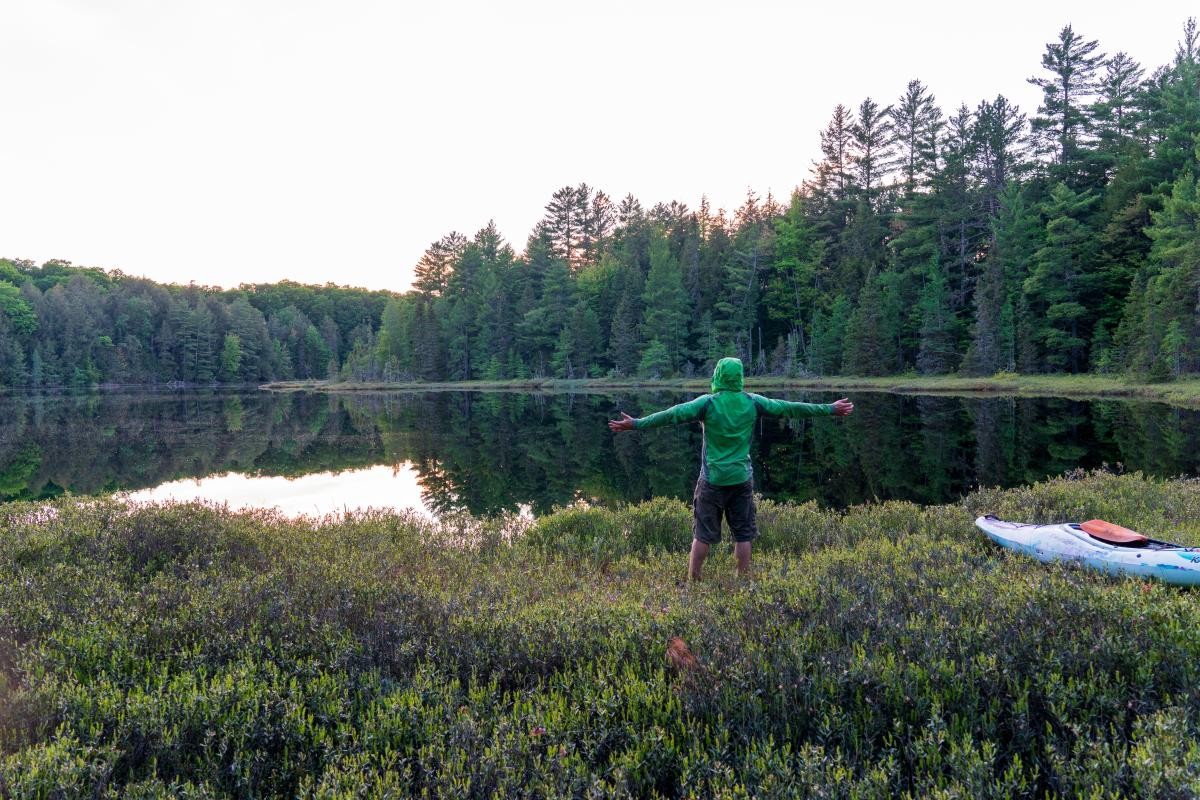The Keweenaw Peninsula is renowned for its breathtaking landscapes, rugged coastlines, and rich history. But there’s another aspect of this stunning region that often goes unmentioned: the bugs! Whether you love them or loathe them, insects are an undeniable part of life here and can significantly impact your outdoor experiences.
But don’t let the thought of bugs deter you! We’ve partnered with local adventurer Nathan Invincible Miller to bring you this comprehensive Bug Guide, sharing his expert tips and tricks for navigating the Keweenaw bug season. From the best times and places to visit to effective strategies for keeping pests at bay, we’ll show you how to ensure your Copper Country getaway remains enjoyable, even with mosquitoes buzzing around.
A prepared adventurer stands ready with bug protection gear by a Keweenaw lake, emphasizing the importance of a bug guide for enjoying the outdoors.
The Unsung Joys of Bug Season (Yes, Really!)
While “bug season” might sound like a period to avoid, the truth is, with the right preparation, you’ll spend far more time reveling in the Keweenaw’s beauty than fleeing from insects. Spring and early summer are truly magical times to witness the peninsula awaken after the long winter months. Wildflowers explode in vibrant colors across the landscape, and every imaginable shade of green emerges in new leaves and shoots. Early-season mushrooms and other wild edibles are abundant for those who know where to look. This period of renewal is a genuine spectacle to behold.
A forager points to oyster mushrooms in a Keweenaw forest, highlighting the spring season’s bounty alongside the need for a bug guide.
Another significant advantage of bug season is the noticeable absence of crowds. In early to mid-June, you’ll often feel like you have the trails and scenic spots all to yourself. If you cherish capturing photos and experiences undisturbed by other visitors, this is the ideal time to come. You might occasionally need to dodge a swarm of black flies, but it’s a small trade-off for experiencing picture-perfect scenery in near solitude.
Understanding Keweenaw Bug Seasons: A Month-by-Month Breakdown
Biting insects in the Keweenaw come in various forms and sizes. While the region is blessed with abundant outdoor recreational opportunities, it’s also home to a diverse range of persistent, biting insects. Knowing when to expect them and where they thrive is crucial for planning your visit. This bug guide breaks down the typical bug seasons in the Keweenaw:
-
Mosquitoes: These long-legged pests are usually the first to appear in springtime, typically arriving in mid to late May and peaking around mid-June. Mosquitoes are ubiquitous but are most concentrated near stagnant water bodies. They are relatively slow fliers, making them easier to swat. Although their numbers decrease by early July, you might still encounter them in smaller numbers throughout the summer. Mosquitoes target exposed skin but can also bite through hair and porous clothing.
-
Black Flies: Small, cunning, and arguably the most bothersome. Black flies emerge in late May and persist into July, reaching their peak in mid-June. Despite their size, they can inflict significant irritation, leaving itchy welts. They are notorious for burrowing into hair and often bite under hat brims. Black flies tend to disappear quickly as summer progresses and can be found almost anywhere outdoors.
-
Deer Flies: As the weather warms up in mid-summer, be prepared for deer flies. Along with horse flies and sand flies, these larger flies are fast, clumsy, and deliver a painful bite. They prefer hot, sunny areas, often found along beaches and shorelines. Deer flies peak briefly in late July and August. Outrunning them is nearly impossible due to their speed; seeking shade is your best defense.
-
No-See-Ums: Also known as biting midges, no-see-ums are incredibly tiny, almost invisible. You’ll know they’re present by the pinprick bite and a small red dot left behind. They are less common and generally less troublesome than mosquitoes or black flies, arriving in mid-summer.
-
Ticks: Though they don’t fly, ticks can significantly disrupt your day if you’re not careful. Precautions are essential against these blood-sucking parasites as they can transmit Lyme disease and other illnesses. The most common types in Michigan are wood ticks (American dog tick) and deer ticks (blacklegged tick). They are active whenever there’s no snow on the ground, prevalent in tall grass, overgrown trails, and wooded areas.
Weather conditions can slightly shift these timelines. Late spring snow and cool temperatures can delay bug emergence, while warm, humid summer days can cause rapid population increases. Conversely, droughts can reduce insect populations but also dry up waterfalls and make trails dusty.
Strategies on How to Avoid Bugs in the Keweenaw
Many biting insects prefer sheltered areas and avoid open spaces with higher winds or less natural habitat. Hilltops like Mount Baldy or Brockway Mountain are excellent examples of bug-free havens. Large bodies of water and the cooler shoreline of Lake Superior also tend to have fewer bugs. This bug guide recommends leveraging these natural bug-repellent zones.
Brockway Mountain Drive offers scenic views and windier conditions, naturally reducing bug presence according to this bug guide.
Another effective escape is to go underground. Mine tours at Quincy Mine, Adventure Mine, and Delaware Mine offer bug-free environments. However, be aware that insects will likely be waiting when you return to the surface!
Finally, consider visiting the Keweenaw during winter. From October to April, you are guaranteed a bug-free experience.
How to Coexist with Bugs and Still Enjoy Your Keweenaw Adventure
As hinted in the previous section, completely avoiding bugs in the Keweenaw is nearly impossible. But that’s perfectly acceptable! Don’t let the potential for bugs ruin your trip. This bug guide offers several effective ways to minimize their impact and enjoy your time outdoors.
Firstly, dress strategically: wear long-sleeved shirts and pants. Bugs can’t bite what they can’t reach. For deep backcountry excursions, consider investing in a head net. For under $10, it provides invaluable relief in heavy bug concentrations. This simple measure is incredibly effective for enduring the peak of bug season. Tucking your pants into your socks also significantly reduces the risk of tick encounters.
A kayaker wearing a bug net showcases proactive bug protection, essential advice from a practical bug guide.
Secondly, use a quality bug spray. Numerous options are available, catering to different preferences regarding chemical content. DEET-based repellents are highly effective, but high concentrations might damage clothing. Apply spray to exposed skin, and watch mosquitoes and black flies veer away (remember to wash hands before eating). Permethrin can be applied to clothing for longer-lasting protection. For those preferring natural alternatives, many essential oil-based repellents smell pleasant and offer some level of protection.
Be adaptable with your location. If June weather is humid (prime bug conditions), head to the lakeshore where cooler temperatures naturally suppress insect activity. The Keweenaw boasts numerous lighthouses that offer scenic views and fewer bugs compared to inland sites. Windy days are your allies! Mosquitoes and black flies struggle in a breeze. Be mindful of sunset times and avoid hiking back in the late evening when mosquitoes and black flies are most active.
A biker actively swats a mosquito, illustrating the “keep moving” tip from an action-oriented bug guide.
Finally, keep moving. Whether you’re mountain biking, ATV riding, hiking, or paddling, avoid lingering in one spot for too long. Biting insects can detect you from considerable distances and will quickly converge on your location. Keep them guessing by minimizing stationary breaks.
Important Tick Awareness for Keweenaw Visitors
Ticks pose a more significant health risk than other biting insects mentioned in this bug guide. While mosquitoes and black flies mainly cause itching and minor blood loss, ticks can transmit diseases like Lyme disease and Rocky Mountain Spotted Fever, with the latter gradually spreading in Michigan. As the climate warms, the risk of other tick-borne illnesses might increase.
After every outdoor excursion, performing a thorough tick check is crucial. Inspect under socks, along legs, armpits, hairline, and groin areas. Ticks prefer hidden spots to attach and feed. If you find a tick, remove it promptly and carefully. Use tweezers to grasp the tick by its head as close to your skin as possible. Pull firmly and steadily to ensure complete removal, then dispose of it properly. Clean and monitor the bite area for several days. Early tick removal usually prevents disease transmission.
A hiker and dog atop Silver Mountain emphasize post-adventure tick checks, a vital part of responsible outdoor activity highlighted in this bug guide.
Remember to check your dogs for ticks as well. Dogs can also contract Lyme disease and experience long-term health issues. Besides preventative flea and tick medications, Lyme disease vaccinations are available for dogs to reduce their risk. Stay safe and enjoy the Keweenaw responsibly!

